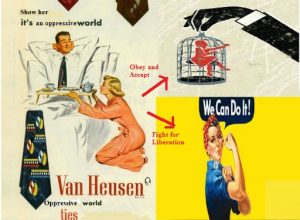
Picture taken from
While I was surfing on the Internet, I came across this Van Heusen advertisement which immediately caught my eyes. There are many elements that stand out in this Van Heusen advertisement. First, there is gender imbalance in the husband-and-wife relationship. As portrayed in the advertisement, the wife is kneeing down on the floor to serve his husband. Through his smiling and relaxing postures, he seems to be pleased for his wife’s and obedience and humbleness. This is definitely not a typical husband and wife relationships but a servant-and-master relationship. Thus, this advertisement is trying to spread gender stereotyping ideas: women are subordinate to men and men have the dominating power in the family. Those ideas restricts women’s capacities and limits their freedom because they define the proper behavior or conduct of women. Those gender stereotypes forces women to stay at home and to take care of the families. The same gender stereotyping ideas are reinforced with terms, such as “man’s world” and “man talking.” Collaboratively, they are trying convey an important message – the world is controlled by male, so women must obey their male counterparts.
This advertisement depicted how western world (more specifically the society and the market) have used popular culture to create gender stereotypes. These gender stereotypes are found everywhere (across cultures). Gender stereotyping is found in many countries, including Asian countries. One good representation is China’s three obedience, found in “Four virtue and Three Obedience.” Three include they include obeying fathers as good daughters, obeying husbands as good wives, and obey sons after widowhood. It was built in ancient China to depict the proper behavior of women within and outside of the houses. Those portrayal is very influential because it is consciously influencing people’s perception of women, and its impacts is still witnessed everywhere, especially in many Asian countries. For example, in my family, I was taught by my mother that women had to respect men. Growing up, I have always doubted why my mother had to do all the house work; on the other hand, my father was sitting on a sofa to watch television.

Jammed Picture
To redesign the advertisement, I have used two editing software: Paint and Pixlr. I used Pixlr to jam three pictures together and used Paint to change slogans. First, in terms of the slogans, I have erased the slogan at the bottom and changed the term “man/men’s world” to “oppressive world.” Through these changes, I want to convey to all women that “sex differs from gender… Social institutions produce observed social differences between men and women (Fausto‐Sterling, 2005, p. 1493).” Gender stereotypes are not born naturally but were socially constructed by male-dominated societies and the market so that men can take advantages of women. For example, women can become reproductive machines and servants for men. Often time, the society manipulated women’s cognition through various methods, such as popular culture and education. Those effects are long-term because media and education system consciously and unconsciously implanted gender discourse on women, and eventually, women cognitively adopted those beliefs. Thus, it is important to reinforce the fact that we, women, are not born with gender stereotypes. Doing so, I hope to increase awareness about sexism.
Next, I have jammed three pictures and added slogans, such as “obey and accept” and “fight for liberation. Through this, I want women to visualize how badly their lives will become if they do not fight for Liberation. Women have two choices. First, by obeying their husbands, women are telling the society that they agree with the oppression, so they have to accept their fate – being treated like an animal. On the other hand, if they choose to fight for their own liberation, they can have a whole new life. This part, I am aiming for women empowerment. I want to spread the fact that women are power with the phrase “We can do it.” Both men are women are equally powerful so it is inappropriate for anyone in a relationships to dominate over the other. Wives and husbands ‘ relationships should be balance. At the end, I want to urge oppressed women to take action. Even though the process may be challenging, women can fight for what they want!!!
References
Correa, V. (2015). A male view on how women have overcome oppression throughout history. Retrieved from http://girltalkhq.com/a-male-view-on-how-women-have-overcome-oppression-throughout-history/
Fausto-Sterling, A (2005). “Bare Bones of Sex: Part I, Sex & Gender.” Signs, 30 (2): 1491-528
Napikoski, L. & Lewis, J. J. (2017). Oppression and women’s history: Women’s history definition. Retrieved from https://www.thoughtco.com/oppression-womens-history-definition-3528977